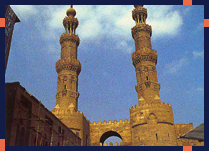Cairo:
History
Fatimid
Cairo: al-Qahira
The
Fatimids (descendants of the Prophet's daughter Fatima and
her husband Ali) founded al-Qahira shortly after the taking
of Fustat in 969. Al-Qahira was designed to house only the
governing elite; the population of Fustat was not initially
allowed to settle here. As Shia Muslims, the ruling dynasty
held different religious views to the Sunni Egyptian population.
Al-Qahira, the area of modern Cairo now called 'Islamic',
formed the centre of the city up until the mid-nineteenth
century.
 |
Islamic
Cairo, perhaps more properly thought of as medieval Cairo,
is an area of narrow streets, covered markets and crumbling
old buildings. Of all Cairo, this quarter most evokes its
past, and in many ways has changed little. It has inspired
many writings, from Arabian Nights to the works of the modern
Nobel laureate Naguib Mahfouz. Getting lost amongst the winding
alleys is almost inevitable and even enjoyable. Visitors are
strongly advised to dress modestly in this part of the city;
many mosques will not allow entry to people in shorts or vest
tops and attentions from the locals (although again inevitable)
will be reduced and more respectful.
The
early Fatimid town (based on the layout of the town of al-Mansuriyya,
Tunisia) was walled with many gates. Three of these still
stand: Bab Zuweila in the south, and Bab al-Nasr (Victory
Gate) and Bab Futuh (Conquests Gate) in the north. The northern
gates, built in 1087 by the Armenian general Badr al-Gamali,
display much foreign influence in their architecture. Entrance
to the towers and walls is through the next door Mosque of
al-Hakim, and re-used Pharaonic blocks and Napoleonic inscriptions
can been seen inside. Bab Futuh and Bab Zuweila were connected
by a main street, al-Qasaba; Sharia ('street') al-Muizz li-Din
follows the same route.
|

|
In
the Mamluk period, Bab Zuweila was the site of public executions;
victims were crucified or sawn in half. The last Mamluk Sultan,
Tumanbey, was hanged from Bab Zuweila in April 1517. The minarets,
which belong to the next door Mosque of al-Muayyad, date from
1422.
One
other institution dates from the original Fatimid town, and
that is the renowned Mosque and University of al-Azhar, founded
in 970 and thus the oldest university in the world. Today,
the Sheikh of al-Azhar is Egypt's equivalent of the Archbishop
of Canterbury. The mosque has been much enlarged; the courtyard
is the earliest part of the structure. The minarets, from
south to north, were built in the fourteenth, fifteenth and
sixteenth centuries.
Only
a handful of Fatimid structures remain. The Mosque of al-Hakim,
completed in 1010, has been re-used as a prisoner-of-war camp,
stables, a warehouse and more recently as a boys' school.
It was also briefly used as a lunatic asylum, appropriately
for a building of the Caliph al-Hakim. This madman disemboweled
his page-boys and executed his officers and citizens as well
as passing laws against dogs and women's shoes. He eventually
proclaimed himself divine, razed Fustat to the ground and
disappeared during a nocturnal mule ride in the Muqattam hills
to the east of Cairo. His mosque was acquired by the Bohras
(an Indian Shia sect) in the 1980s and has been renovated
in an unsympathetic way. The area around this building was
until after 1900 a slave market; now garlic and onions are
sold here in huge quantities.
Also
worth visiting are the al-Aqmar Mosque, built in 1125 and
the Mosque of Salih Talai, built in 1160. The former, called
'the Moonlit', is the earliest stone-fašaded mosque in Egypt
and is architecturally innovative in other ways. The latter,
just outside Bab Zuweila, was funded by the rents from shops
which stood beneath it. Both structures were originally at
ground level; the streets have risen considerably since the
Fatimid period.
The
Southern Cemetery, south of the Citadel, also belongs to Fatimid
Cairo, but it is well off the beaten track and not easy to
reach. Attractions include the Mausoleum of Imam al-Shafi
(founded by Salah al-Din, known to the west as 'Saladin',
in the twelfth century, but little of the original survives),
the Mausoleum of the Ottoman ruler Mohammed Ali's family and
a giant bric-a-brac and animal market (not for the squeamish).
(Alison
Gascoigne)
|